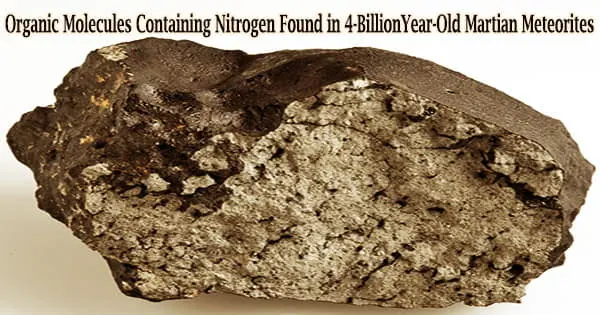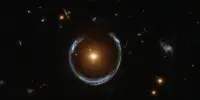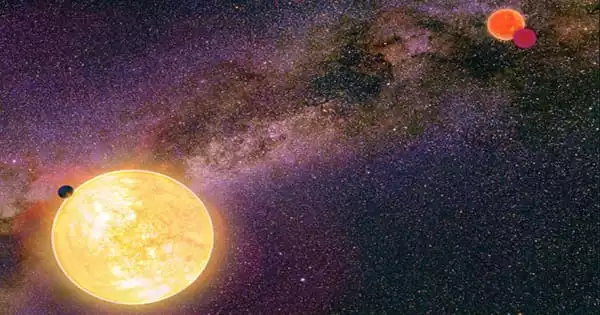A research team led by Atsuko Kobayashi of the Earth-Life Science Institute (ELSI) at Tokyo Institute of Technology and Mizuho Koike of the Japan Aerospace Exploration Agency’s Institute of Space and Astronautical Science discovered nitrogen-bearing organic material in carbonate minerals in a Martian meteorite. Since Mars’ Noachian period, this biological material has most likely been maintained for 4 billion years.
This discovery supports a moist and organic-rich early Mars, which could have been livable and conducive for life to begin, because carbonate minerals normally precipitate from groundwater. Scientists have spent decades trying to figure out whether organic chemicals exist on Mars and, if so, where they come from.
Although recent rover-based Mars investigation has found substantial evidence for Martian organics, nothing is known about where they came from, how old they are, how widely distributed and preserved they are, or what their likely relationship with biological activity is.
Martian meteorites are fragments of Mars’ surface that were blasted into space by meteor strikes and eventually landed on Earth. They reveal significant details about Martian history.
A meteorite named Allan Hills (ALH) 84001, named for the region in Antarctica where it was discovered in 1984, is very significant. It comprises orange-colored carbonate minerals that formed 4 billion years ago on Mars’ near-surface from salty liquid water.
Many research have tried to understand their peculiar chemistry and whether they can provide evidence for ancient life on Mars because these minerals reflect Mars’ early aquatic environment.
However, prior examinations were contaminated with Antarctic snow and ice, making it difficult to determine how much of the organic stuff in the meteorite was actually Martian.
There are two main possibilities: either they came from outside Mars, or they formed on Mars. Early in the Solar System’s history, Mars was likely showered with significant amounts of organic matter, for example from carbon-rich meteorites, comets, and dust particles. Some of them may have dissolved in the brine and been trapped inside the carbonates.
Atsuko Kobayashi
Nitrogen (N) is an essential element for terrestrial life and a useful tracer for planetary system evolution, in addition to carbon. However, nitrogen has not yet been measured in ALH84001 due to earlier technical restrictions.
The ALH84001 carbonates were studied using state-of-the-art analytical techniques by the joint ELSI-JAXA team, and the team is now certain they have discovered the first convincing evidence for 4-billion-year-old Martian organics including nitrogen.
Contamination from the Earth is a severe issue in the study of alien materials. To avoid contamination, the researchers devised novel sample preparation techniques.
They utilized silver tape in an ELSI clean lab to remove microscopic carbonate grains from the host meteorite, which are roughly the width of a human hair. Using a scanning electron microscope-focused ion beam device at JAXA, the scientists further processed these grains to remove any surface contamination.
They also used a technique known as Nitrogen K-edge micro X-ray Absorption Near-Edge Structure (-XANES) spectroscopy, which allowed researchers to detect nitrogen in very small concentrations and determine its chemical form.
Nitrogen was not detected in neighboring igneous minerals, indicating that the organic molecules were only found in the carbonate.
The researchers found that the identified organics were most likely truly Martian after extensive contamination checks.
They also discovered that nitrogen in the form of nitrate, one of the powerful oxidants on contemporary Mars, had a negligible contribution, implying that early Mars did not contain strong oxidants and was, as scientists thought, less oxidizing than it is now.
Most biological life cannot exist on Mars’ current surface. Organic chemicals, on the other hand, are expected to last billions of years in near-surface environments, according to scientists.
This appears to be the case with the nitrogen-bearing organic compounds discovered by the scientists in the ALH84001 carbonates, which were trapped in the rocks 4 billion years ago and kept for long periods of time before being brought to Earth.
The researchers believe that many critical questions remain unanswered, such as where did these nitrogen-containing organics come from. Kobayashi explains:
“There are two main possibilities: either they came from outside Mars, or they formed on Mars. Early in the Solar System’s history, Mars was likely showered with significant amounts of organic matter, for example from carbon-rich meteorites, comets, and dust particles. Some of them may have dissolved in the brine and been trapped inside the carbonates.”
Alternatively, chemical reactions on early Mars could have created N-bearing organics on-site, according to Koike, the research team’s leader. These findings, they claim, reveal that organic nitrogen existed on Mars before it turned into the red planet we know today; early Mars may have been more ‘Earth-like,’ less oxidizing, wetter, and organic-rich. Maybe it was ‘blue.’
















